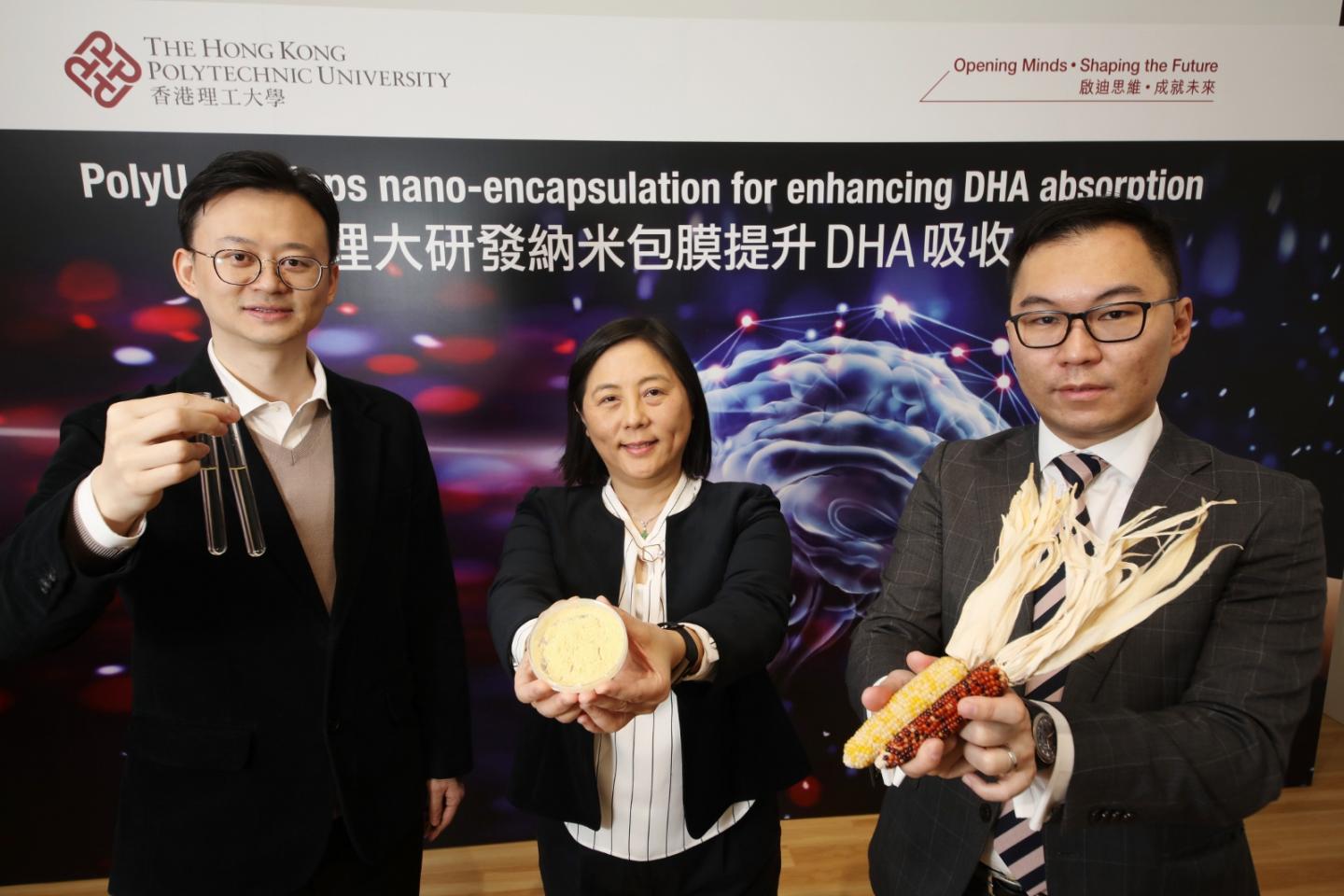
Credit: The Hong Kong Polytechnic University
The Hong Kong Polytechnic University (PolyU) today announced the findings on its novel nano-encapsulation technology for optimising the maternal and fetal absorption of docosahexaenoic acid (DHA). The research, conducted by PolyU’s Department of Applied Biology and Chemical Technology (ABCT), aimed to address the delivery and absorption issues of DHA that affect its potency and efficacy.
DHA, a type of Omega-3 fatty acid naturally found in breast milk and fish oil, is an important nutrient for the development and function of brain. It is primarily obtained from diet, and preferentially transferred from mother to fetus across the placenta during fetal life. However, for people with problem in getting sufficient DHA from normal dietary sources, particularly those in late pregnancy, early childhood, or with cancer or declining cognitive abilities, DHA supplementation is recommended. Given DHA is highly unsaturated and is vulnerable to oxidation and degradation under acid conditions, it is uncertain that the intake of DHA through supplementation will be effectively delivered and absorbed in vivo.
Led by Dr Wang Yi, Assistant Professor of ABCT, and Professor Wong Man-sau, Professor of ABCT, the research team innovated a nano-encapsulation technology to protect DHA from oxidation. The team used Zein, an edible corn protein, as the encapsulation material to mimic milk fat globule membrane. The nano-encapsulation forms a core-shell structure to protect DHA in fish oil throughout gastric digestion and facilitate DHA absorption in brain, intestine and placenta.
“Our team innovated the nano-encapsulation technology, which is proven to be an effective technology to protect DHA from oxidation in vivo, thus enhancing the absorption and efficacy of DHA. Our findings also indicated that the technology can help overcome blood-brain barrier in DHA delivery. We therefore believe that the technology could be further applied to enhance the efficiency of drug delivery for the brain, such as those for patients with dementia or Alzheimer’s disease,” said Dr Wang Yi.
DHA in maternal tissues
To test the effectiveness of nano-encapsulation technology in enhancing DHA absorption, PolyU’s team conducted some experiments on maternal mice and their offsprings.
In two groups of maternal mice, each of six, fed with normal fish oil (Normal FO) and nano-encapsulated fish oil (Nano FO) respectively, it was found that the DHA concentration in the duodenum and jejunum of the Nano FO group is significantly higher than the Normal FO group (see Figure 1). The result implies that DHA, being protected by the encapsulation structure from oxidation and degradation under stomach’s acidic conditions, is successfully released in the upper two parts of the small intestine of the Nano FO group.
Also, the DHA contents in the brain of the Nano FO maternal mice were significantly higher (see Figure 2). This indicates that DHA was delivered to the brain of the Nano FO group more effectively as the challenge of the blood-brain barrier was overcome.
DHA in the offsprings
The team also conducted tracer studies on the offsprings of the maternal mice. The mice were divided into six groups, each with 10, and were fed with different diets including: 1) no DHA meal; 2) Zein; 3) normal low dose fish oil (Normal FO-low); 4) normal high dose fish oil (Normal FO-high); 5) Nano-encapsulated low dose fish oil (Nano FO-low); and 6) Nano-encapsulated high dose fish oil (Nano FO-high).
The findings showed that the three groups, namely: Normal FO-high, Nano FO-low and Nano FO-high spent more time on novel objects rather than on familiar objects (see Figure 3), implying that they were more curious about new things and demonstrated better memory and learning capabilities.
For the Nano FO-high group, they had higher amount of Brain-Derived Neurotrophic Factor (BDNF) in hippocampus (see Figure 4). BDNF, a protein activated by DHA, plays an important role in supporting the survival of existing brain neurons and encouraging the growth and differentiation of new neurons and synapses. They also demonstrated a significant difference to other groups in terms of better spatial learning and memory abilities in the Y-maze experiment (see Figure 5).
###
The research project was funded by the Health and Medical Research Fund (HMRF) of the Food and Health Bureau of the Hong Kong SAR Government and the Shenzhen Basic Research (Layout of Disciplines) Project Fund.
Media Contact
Christina Wu
[email protected]
852-340-02130
Related Journal Article
http://dx.




